Are proposed changes moving the UDO backward?
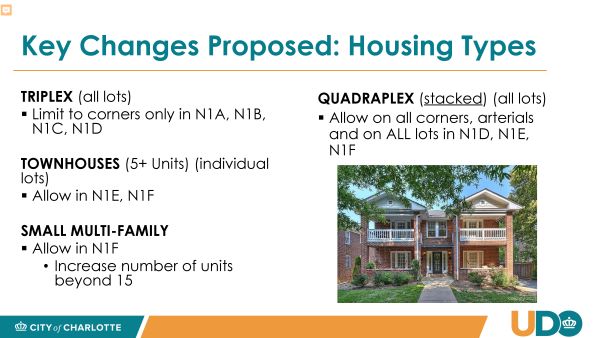
As we learned in this month’s Transportation, Planning, and Development committee meeting, the city’s planning staff is working on options for the referral concerning duplexes and triplexes requested by the council last year.
The reason for this referral was the use of the by-right Neighborhood 1 zoning for large projects consisting of all duplexes and triplexes. While working on this referral, planning staff discovered that more than 90% of developments used the conservation option.
This resulted in a misinterpretation of the intended use of this type of development, leading to poorly designed projects that maximized housing units at the expense of quality. As a result, the primary guidance used by staff to propose solutions has centered around these three items:
- Quantity: Require mix of housing types in any development over five acres with duplexes and triplexes
- Quality: Modify the development standards to increase open space, buffers between developments and other standards that impact walkability and livability
- Location: Add locational qualities to limit large developments of duplexes and triplexes in areas not targeted for growth
Below is a comprehensive explanation of what’s at stake, but first, here’s our take:
We support building more housing options, including duplexes and triplexes, but the Charlotte area also needs even higher-density options, like stacked quads and townhomes. This has to happen thoughtfully and logically.
Allowing hundreds of housing units in locations lacking basic infrastructure and services will only perpetuate the sprawl and force even more residents to drive. The better solution lies with half of the N1 districts, allowing more density while reducing some density for the other half.
Since the zoning in place currently has not been realigned in decades (it just changed names with the UDO), we need to push the city to realign the zoning in which it transitions the densest districts from our centers outwards to the less dense ones.
HOW WE COMPARE TO OUR PEERS
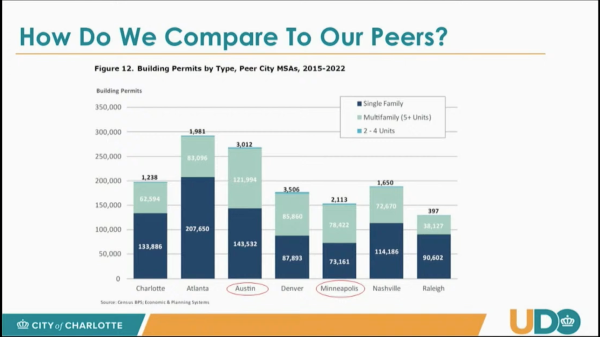
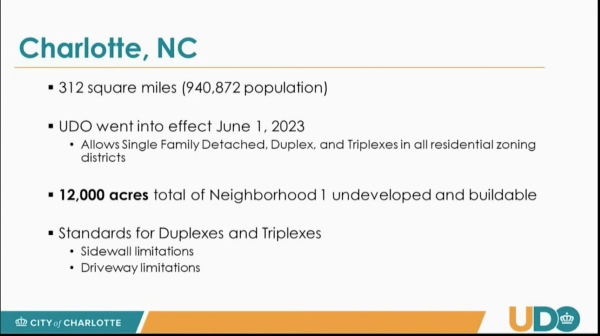
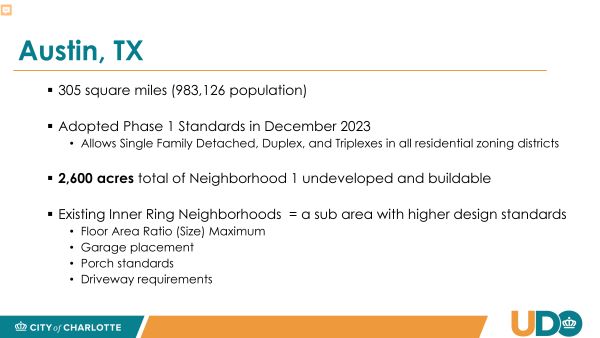
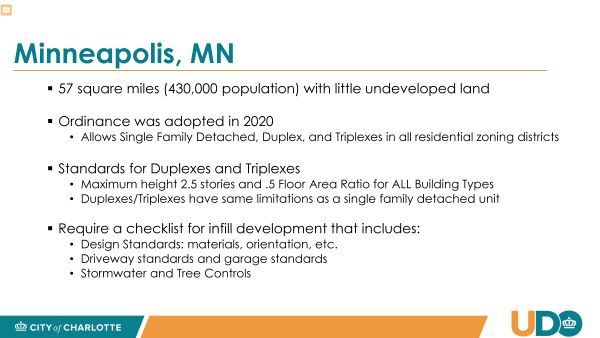
WHAT WAS PROPOSED BY THE STAFF?
The city staff is working to address the referral on two separate levels regarding duplexes and triplexes. One is a sizable subdivision comprising all triplexes or duplexes (shown below). The other is an infill on a single lot, which usually occurs over time and has a smaller impact on infrastructure.
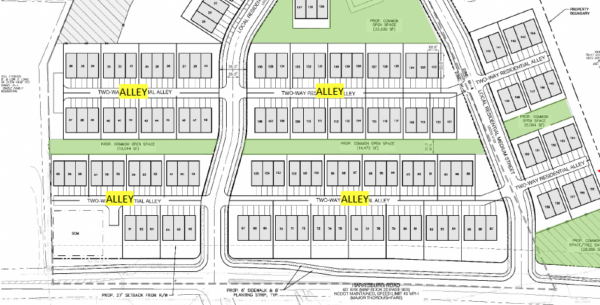
More significant developments in the form of subdivisions
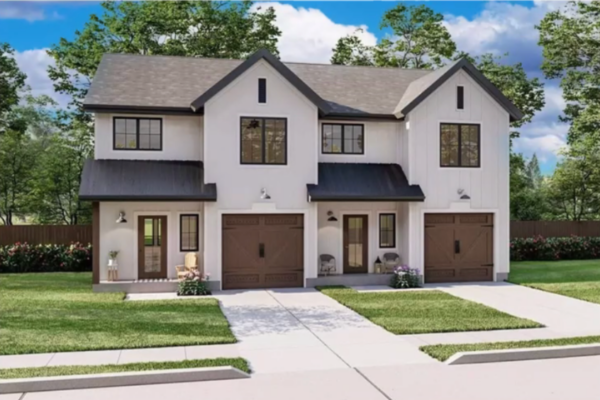
Individual lots/Infill development
CHANGES PROPOSED TO SUBDIVISIONS
- A text amendment to improve the quality of the Conservation Development standards has already been filed. This option for subdivisions was originally meant to emphasize the importance of the conservation of natural areas and important habitats, enhance surface water quality, maintain and enhance the tree canopy, protect natural areas, and provide useable common open space for residents. This ended up compromising 90%+ of all the subdivisions filed since the UDO took effect last year.
Changes would restore this original intent and improve the quality of those developments. Here is the current schedule for this text amendment:

- Add a new Compact Development standard for subdivisions over 2 acres that incorporates best practices in development standards.
The key elements of the proposed Compact Development option would:
- Update and revise standards similar to Cluster Development that existed in the previous ordinance
- Allow smaller lot development with a provision for more tree save/open space, adding 5% more open space
- Be allowed within 1-mile proximity to Center place type and high-performance transit corridor
- Place more density near existing infrastructure
- Allow affordable housing projects to use this option throughout Charlotte
Here is the estimated timeline for this proposed text amendment that has not yet been filed.

CHANGES PROPOSED FOR INFILL DEVELOPMENT
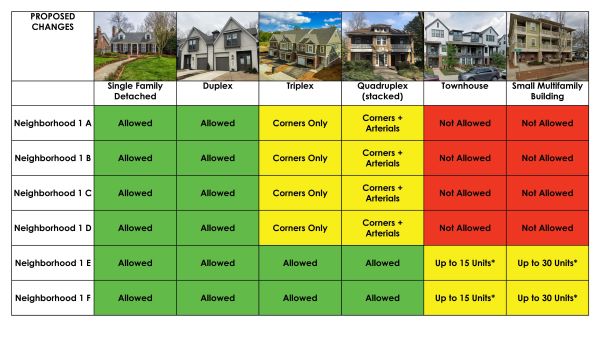
Table presented to UAC by planning staff; details are subject to change
The summary table above outlines the proposed modifications to N1 development, including single-lot infill development. At present, staff recommends restricting triplexes to corner lots in N1-A to D. These changes would also apply to larger subdivision development projects. However, if the proposed Compact Development option is approved, it would lead to the upzoning mentioned in the image below, and whatever adjusted zoning district would follow the same rules depicted in the table above.
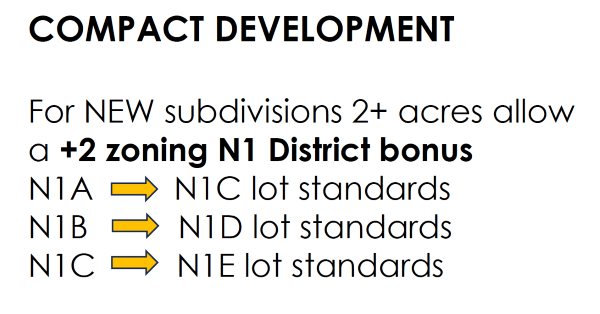
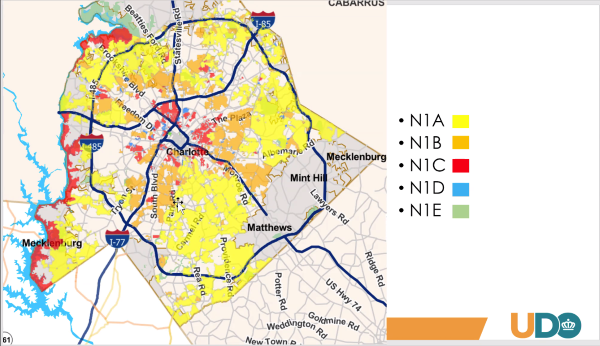
This map represents the current zoning on the ground in Charlotte
Given that the majority of the N1 zoning consists of N1-A and N1-B, triplexes will be very limited with this recommendation. One very important factor to consider is that the map is not static and is in the very early stages of being reworked. There will be several more steps before the realignment rezoning will occur but a step in that direction is happening now. This includes the second update to the policy map, and the draft is currently available for commenting here.
WHAT ARE THE COUNCIL COMMITTEE MEMBERS SAYING AND ASKING STAFF TO ADDRESS?
Several council members expressed their opinions:
- Johnson – “Know that we need density but don’t want to negatively affect neighborhoods. Need to look at subdivisions that are less than 5 acres too. We have to simplify this information”
- Driggs – “My impression was that our lowest density residential would be a mix of housing types including a substantial portion of single family. There is a point at which, when you simplify, you misrepresent and therefore our desire to be transparent, which is a key priority of yours, necessitates a certain amount of information. You can’t get around it.”
- Watlington – “I hope we can move forward with these recommendations to really right-size density in the appropriate places. Look forward to improving the process and continually as we learn more about what our peer cities are doing, as we learn more about what is happening and what impact is on the ground, I appreciate this particular recommendation set comes with a more nuanced understanding of what’s different about our peer cities.”
WHY DOES THIS MATTER, AND WHAT’S NEXT?
The UDO has been in effect for less than a year. It’s normal to make minor adjustments during this period. However, it is crucial to exercise caution and take a careful approach before removing or significantly changing any of its components. This approach allows the planning staff, residents, and the developer community sufficient time to comprehend and diagnose the interconnected issues that arise with a new ordinance.
Housing diversity is critical to affordability and quality of life. For many decades, Charlotte has built only single-family housing and mid-rise apartments. Having only two choices will not work for families, neighborhoods, young people just starting on their own, and older people looking to downsize. How will the proposed changes impact affordable housing developers like Habitat for Humanity?
We have been working closely with the planning staff in our role as a member of the UDO Advisory Committee (UAC). Our main objective is to maintain the availability of diverse housing options in Charlotte by preventing the exclusion of the missing middle housing from the UDO. We are committed to pursuing these goals while adhering to the principles of smart growth, and we value the collaborative efforts of all parties involved in this important process.
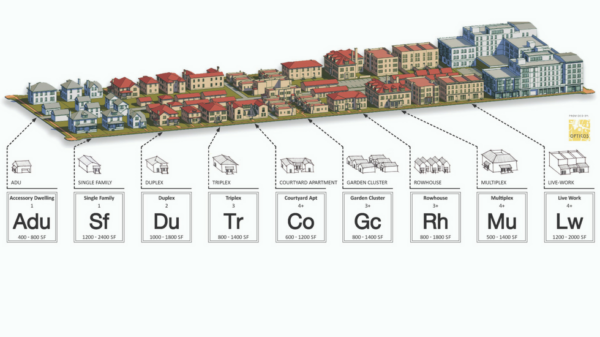
Missing+Middle+Housing+Diagram
THANKS FOR READING!
As a nonprofit, community support is essential for us to keep doing what we do — including providing free articles like this. If you found this article helpful, please consider supporting Sustain Charlotte.
Want to stay in the loop? Subscribe to our weekly newsletter and follow us on Instagram, Facebook, and Twitter.
